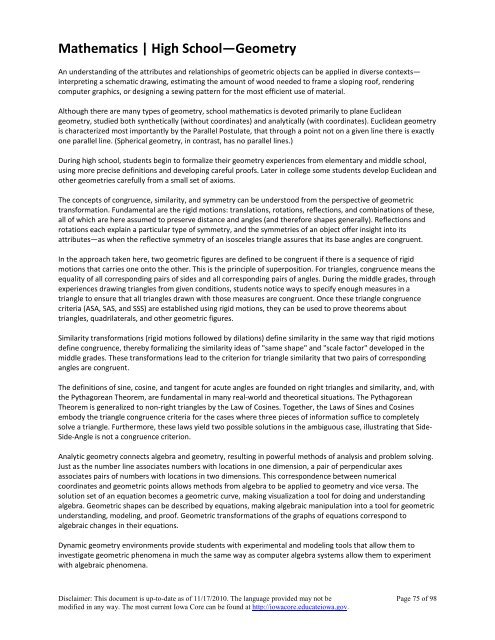Iowa Core K-12 Mathematics (PDF) - Green Hills AEA
Iowa Core K-12 Mathematics (PDF) - Green Hills AEA
Iowa Core K-12 Mathematics (PDF) - Green Hills AEA
Create successful ePaper yourself
Turn your PDF publications into a flip-book with our unique Google optimized e-Paper software.
<strong>Mathematics</strong> | High School—Geometry<br />
An understanding of the attributes and relationships of geometric objects can be applied in diverse contexts—<br />
interpreting a schematic drawing, estimating the amount of wood needed to frame a sloping roof, rendering<br />
computer graphics, or designing a sewing pattern for the most efficient use of material.<br />
Although there are many types of geometry, school mathematics is devoted primarily to plane Euclidean<br />
geometry, studied both synthetically (without coordinates) and analytically (with coordinates). Euclidean geometry<br />
is characterized most importantly by the Parallel Postulate, that through a point not on a given line there is exactly<br />
one parallel line. (Spherical geometry, in contrast, has no parallel lines.)<br />
During high school, students begin to formalize their geometry experiences from elementary and middle school,<br />
using more precise definitions and developing careful proofs. Later in college some students develop Euclidean and<br />
other geometries carefully from a small set of axioms.<br />
The concepts of congruence, similarity, and symmetry can be understood from the perspective of geometric<br />
transformation. Fundamental are the rigid motions: translations, rotations, reflections, and combinations of these,<br />
all of which are here assumed to preserve distance and angles (and therefore shapes generally). Reflections and<br />
rotations each explain a particular type of symmetry, and the symmetries of an object offer insight into its<br />
attributes—as when the reflective symmetry of an isosceles triangle assures that its base angles are congruent.<br />
In the approach taken here, two geometric figures are defined to be congruent if there is a sequence of rigid<br />
motions that carries one onto the other. This is the principle of superposition. For triangles, congruence means the<br />
equality of all corresponding pairs of sides and all corresponding pairs of angles. During the middle grades, through<br />
experiences drawing triangles from given conditions, students notice ways to specify enough measures in a<br />
triangle to ensure that all triangles drawn with those measures are congruent. Once these triangle congruence<br />
criteria (ASA, SAS, and SSS) are established using rigid motions, they can be used to prove theorems about<br />
triangles, quadrilaterals, and other geometric figures.<br />
Similarity transformations (rigid motions followed by dilations) define similarity in the same way that rigid motions<br />
define congruence, thereby formalizing the similarity ideas of "same shape" and "scale factor" developed in the<br />
middle grades. These transformations lead to the criterion for triangle similarity that two pairs of corresponding<br />
angles are congruent.<br />
The definitions of sine, cosine, and tangent for acute angles are founded on right triangles and similarity, and, with<br />
the Pythagorean Theorem, are fundamental in many real-world and theoretical situations. The Pythagorean<br />
Theorem is generalized to non-right triangles by the Law of Cosines. Together, the Laws of Sines and Cosines<br />
embody the triangle congruence criteria for the cases where three pieces of information suffice to completely<br />
solve a triangle. Furthermore, these laws yield two possible solutions in the ambiguous case, illustrating that Side-<br />
Side-Angle is not a congruence criterion.<br />
Analytic geometry connects algebra and geometry, resulting in powerful methods of analysis and problem solving.<br />
Just as the number line associates numbers with locations in one dimension, a pair of perpendicular axes<br />
associates pairs of numbers with locations in two dimensions. This correspondence between numerical<br />
coordinates and geometric points allows methods from algebra to be applied to geometry and vice versa. The<br />
solution set of an equation becomes a geometric curve, making visualization a tool for doing and understanding<br />
algebra. Geometric shapes can be described by equations, making algebraic manipulation into a tool for geometric<br />
understanding, modeling, and proof. Geometric transformations of the graphs of equations correspond to<br />
algebraic changes in their equations.<br />
Dynamic geometry environments provide students with experimental and modeling tools that allow them to<br />
investigate geometric phenomena in much the same way as computer algebra systems allow them to experiment<br />
with algebraic phenomena.<br />
Disclaimer: This document is up-to-date as of 11/17/2010. The language provided may not be Page 75 of 98<br />
modified in any way. The most current <strong>Iowa</strong> <strong>Core</strong> can be found at http://iowacore.educateiowa.gov.
















